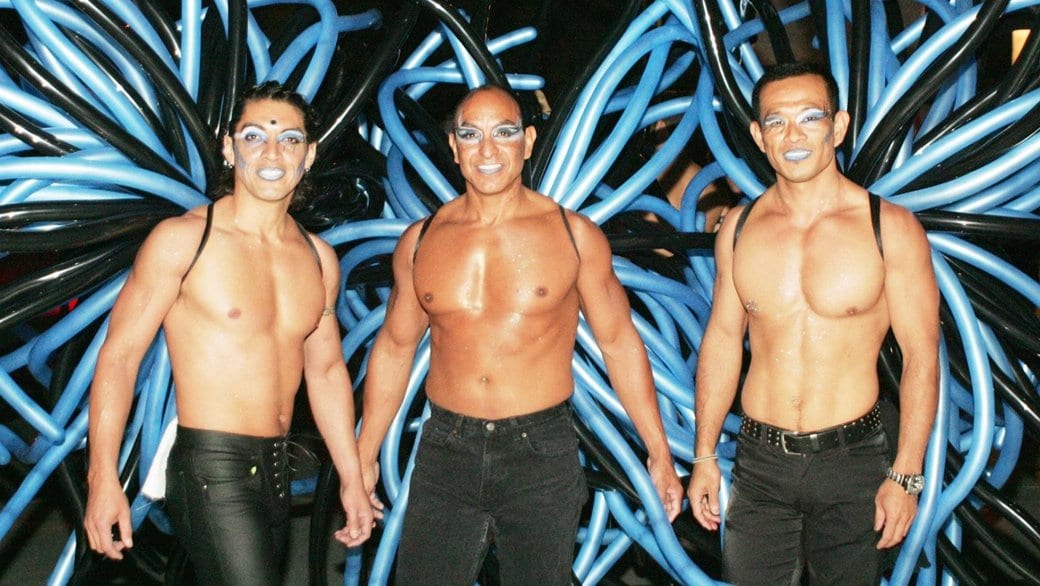The first time I went to Black and Blue was in 2005, back when it was still held Olympic stadium in Montreal. It was a very different time; facial hair wasn’t cool yet and everyone was still waxing their chests.
In Toronto, Fly nightclub was “1.0” and locals would brag that it was Babylon from Queer as Folk. The infamous Trade party in London, which was the capital’s first ever legal afterhours club was still being held at Turnmills, and in New York City you could hear Peter Rauhofer play all night long at The Roxy. I’d only just started going to circuit parties myself, but if the circuit era hadn’t already ended, this was certainly the tail end of it. Yet 11 years later, the Black and Blue main event is still going strong.
Inspired by the disco movement, circuit parties started as a transcontinental scene, which existed between The Saint nightclub in New York City, The Probe in Los Angeles, and then Hotlanta in Atlanta, Georgia held each summer. Gay men would migrate, cross country between the gay meccas in search of a good time, but over the years, more parties joined the circuit, like Southern Decadence, the Miami White Party, and even an event at Disney Hollywood Studios, One Magical Weekend.
In the shadow of the AIDS epidemic, it’s been said that these parties were an attempt to recapture the ’70s; a much more idyllic era, where it seemed as though there weren’t consequences to partying and sex. Circuit parties became a way to express one’s self — to heal, celebrate and bond with other gay men, while perhaps experiencing something more spiritual (with the help of substances and the right kind of sound). With this scene came controversy, due to excessive drug use by some, and risky sexual behavior.
Black and Blue started in 1991 in an abandoned bank. Over 800 people showed up, but by 2002, that number grew to 80,000. They had revellers coming from all over Canada, the United States, Europe, Australia, South America and New Zealand — it earned its rightful place on the global circuit. Now, the Black and Blue festival is a seven-day event full of social and cultural activities. Although last year only had 30,000 people in attendance, a significant decrease from 2002, it still manages to attract huge international crowds. This year the 26th Annual Black and Blue Festival is from Oct 5–11, 2016, and the main event is on Oct 9. So how has this circuit party remained relevant?
“We don’t really consider the festival a traditional ‘circuit party.’ I think that’s what has kept the festival going strong all these years,” says Robert Vezina, resident and founder of the BBCM Foundation, the organization that produces the event each year.
“Since 1995, we have actively taken steps to mix the ‘traditional circuit party’ with the ‘electronic music festival,’” he continues. “We have done this by increasing the size and scope of the festival, included numerous community events, such as theatre performances, museum visits, brunches, art exhibits, etc.”
It certainly isn’t your traditional circuit or EDM festival. The BBCM Foundation is a registered non-profit; In their first year, they raised $3,500 for AIDS Community Care Montreal. Since then, the foundation has donated up to $1,400,000, supporting many of Montreal’s HIV/AIDS organizations.
Last year alone, they raised $30,000 to help provide direct care to people living with HIV/AIDS, and contributed funds to other gay and lesbian community organizations. In an effort to combat the issues faced by the party scene, they’ve been diligent in promoting safer sexual practices and responsible drug use. But good intentions alone can’t keep a party going for decades, as has been the case with Black and Blue.
“I think the main challenge is to stay relevant to today’s markets. From attracting a younger crowd, like with our new Twinkle party,” Vezina says. This party will be held at Unity and is geared towards pop music lovers in an apparent effort to keep ahead of the progression within the music scene, he explains.
Black and Blue has also diversified by making it a much more inclusive party. They’ve successfully created a non-discriminatory environment where both men and women are welcome, along with gay and straight folks, too. In a 2010 interview with Daily Xtra, Vezina mentioned that the fact that Black and Blue isn’t strictly a gay party may be another reason for its longevity. “The ratio of about 75 percent LGBT to 25 percent straight,” he explains. “But of course, everyone is welcome.”
The events surrounding Black and Blue are just as diverse as the attendees, providing a little bit of something for everybody.
There is Bal En Cuir on the Friday, a leather ball, which will be held at Bain Mathieu, an old, emptied out swimming pool. Then there’s Bears & Friends on the Saturday at the same venue for, well, bears, their friends and probably some cubs, otters, polar bears and wolves too. The main event is on Sunday, Oct 9, but like any big festival, there’s a Recovery Party on the Monday. There are also cocktail parties, drag shows, brunches and early morning afterhour parties in proper Montreal style, if one chooses to dance all weekend long.
The Black and Blue Festival is obviously doing something right to have lasted so long, evolving with the very fickle party scene. But it does help that it’s in Montreal, Vezina explains: “The support of the government as well as the complex nature of Montreal truly help separate us other of similar events.”
“It doesn’t hurt that Montreal has a great reputation for being one of the best places on earth to go if you want to have a good time.”
Black and Blue Festival
Oct 5–11, 2016
Tickets can be purchased at bbcm.electrostub.com.

 Why you can trust Xtra
Why you can trust Xtra


